Features of the heating system with forced circulation
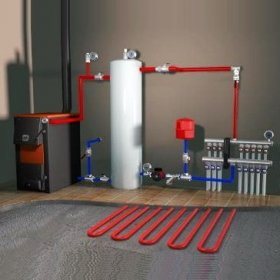
Heating a house or cottage can be achieved using one of two types of heating systems that differ from each other in the way the coolant circulates. With the natural movement of water or antifreeze through the pipes, it is not necessary to use additional equipment, but it is necessary to ensure the corresponding slope of the pipeline main. If a heating circuit with forced circulation is selected, then a circulation pump crashes into the pipeline, which is responsible for the speed of the coolant in the heating system. The higher this indicator, the faster all rooms in the house warm up. The operation of the circulation pump depends on the availability of electricity, therefore, with possible interruptions in the supply of electricity and blackouts for a long time, you need to stock up on a gas generator.
Content
What is the difference between open systems and closed?
Any hydraulic heating system can be represented in the form of a complex of heating equipment and heating devices, combined in a certain order into a single unit using pipes.
In heating systems, an expansion tank is installed, since the heating coolant increases in volume. If the tank communicates with the outside air, then the heating system is called open. By isolating the expansion tank from interaction with atmospheric air, a closed heating system is obtained. AT open systems the coolant evaporates, so you have to monitor the water level in the tank and top up when such a need arises. AT closed systemsequipped with expansion tanks of the membrane type, this problem does not occur.

Installation of a heating system including a boiler, an open expansion tank, radiators, shutoff valves, air vents, a circulation pump that provides forced circulation of the coolant
Why install a circulation pump?
Advantages of installing a circulation pump:
- Installation is simplified, since there is no need to build a complex and uncomfortable upper piping with observance of the slope angle. It is not required to build the main risers from pipes of a larger diameter. Thanks to this, it is possible to improve the interior of the room.
- You can choose the collector type of piping, which ensures uniform heating of all heating devices, regardless of the degree of their remoteness from the boiler.
- There is a possibility of increasing the length of pipelines.
- With a forcibly circulating carrier, additional elements can be integrated into the heating system, for example, “warm floors”.
The circulation pump is installed in front of the heating boiler on the return main pipe. It is also recommended to install a membrane (expansion) tank, which is an essential element of a closed heating system.
Closed heating elements
The main elements of a forced circulation heating system are:
- boiler (solid fuel, gas, etc.);
- expansion sealed tank membrane type;
- selected circulation pump;
- radiators (batteries) for heating;
- pipes for the construction of risers, lintels and hoses;
- adapters for connecting pipes (fittings);
- ball and plug valves;
- check valves;
- air vents;
- filters necessary to maintain the efficiency of the boiler and pumps;
- fixing devices (clamps, etc.).
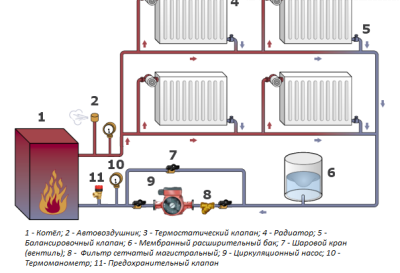
Scheme of a device in a private house of a closed heating system with a circulation pump and a sealed membrane tank installed on the return
Important points for installation
In order for heating with forced circulation to function without problems for a long time, it is necessary to correctly install the important components on which the effectiveness of the entire system depends.
To increase the life of the circulation pump, it is cut into the return line. The explanation is simple. Water moves in a chilled form through the return pipe, since the heat has already been given to heating devices. In the design of the pump, manufacturers use cuffs and seals made of rubber, which can change properties under constant exposure to high temperatures. The cooled coolant entering the return does not have a significant effect on the rubber parts, which allows them to retain their original properties longer.
To install a forced heating system, pipes with a minimum diameter can be used. At the same time, it is possible to reduce the cost of installing a heating system at home. After all, the volume of coolant that fills the system is reduced. This in turn affects the choice of the expansion tank of the appropriate volume and capacity of the purchased boiler.
In heating systems with forced circulation, it is recommended to use modern heating boilers, the design of which provides for the availability of automation. These devices provide control and regulation of all processes with minimal human intervention in the operation of the equipment. It uses fuel more efficiently and regulates the temperature inside the room, taking into account various factors that affect the course of the home heating process.
How to choose a circulation pump model?
When choosing pumping equipment, attention is paid to the simplicity and reliability of its operation, as well as to energy consumption. In addition to these important qualities, pump power and pressure are important. These characteristics are determined by the size of the heated room. You can focus on the following examples:
- for houses with an area of 250 square meters. meters, they acquire pumps with a pressure of 0.4 atmosphere and a capacity of 3.5 cubic meters. meters per hour;
- for houses, the area of which is in the range of 250-350 square meters. meters, they acquire pumps with a pressure of 0.6 atmospheres and a capacity of 4.5 cubic meters. m / h;
- for houses with an area of more than 350 square meters. meters, reaching 800 square meters. meters, acquire pumps with a pressure of 0.8 atm. And a capacity of 11 cubic meters. m / h
With a more accurate selection of the circulation pump for a particular object, calculations are carried out by specialists taking into account the length of the entire system, the number of installed radiators and their type, the used valves, the diameter of the pipes, as well as the material of their manufacture, type of fuel. For more details see the article »Selection and nuances of installing a circulation pump for heating».
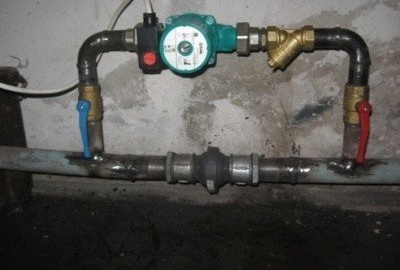
Mounting the circulation pump on a bypass (jumper) makes it easy to remove equipment for replacement or routine repair and maintenance
Air congestion formed in each radiator and in places where the pipeline rises vertically can interfere with the normal circulation of the coolant in the heating system. You can deal with accumulations of air by installing Mayevsky taps on each radiator or special automatic air vents. Installation of these devices will prevent "airing" of individual sections of the system and disturbances in the operation of heating, affecting the microclimate in the room.
Advantages of installing a two-pipe system
When designing forced-circulation water heating for a private house, one-pipe or two-pipe scheme is selected based on the material capabilities of the owner. A single-pipe system is cheaper, easier to install, and a two-pipe system is more efficient in operation. When installing a horizontal two-pipe heating system, three schemes for laying the pipeline are possible: dead-end, associated and collector.
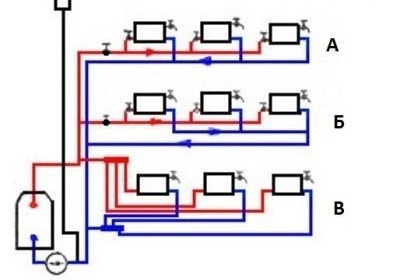
Three schemes for installing a horizontal two-pipe heating system in a private house: A) dead-end; B) associated; B) collector (beam)
We note right away that the latter is most effective, namely pipe manifold. However, when it is implemented, the consumption of materials increases, as well as the complexity of the installation work.
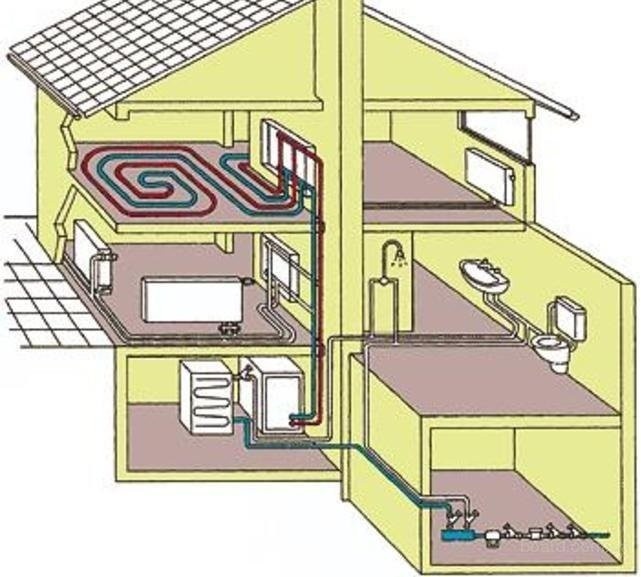

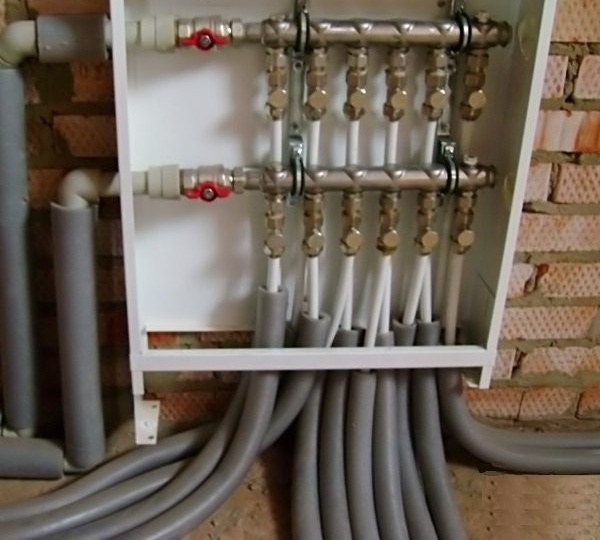
1 comment